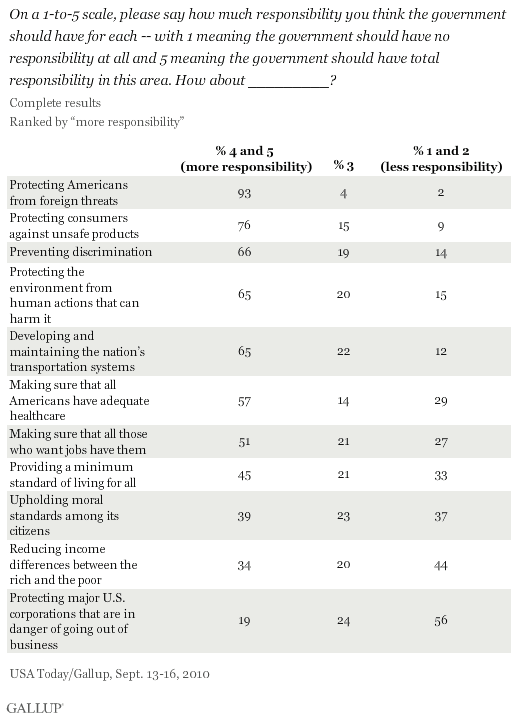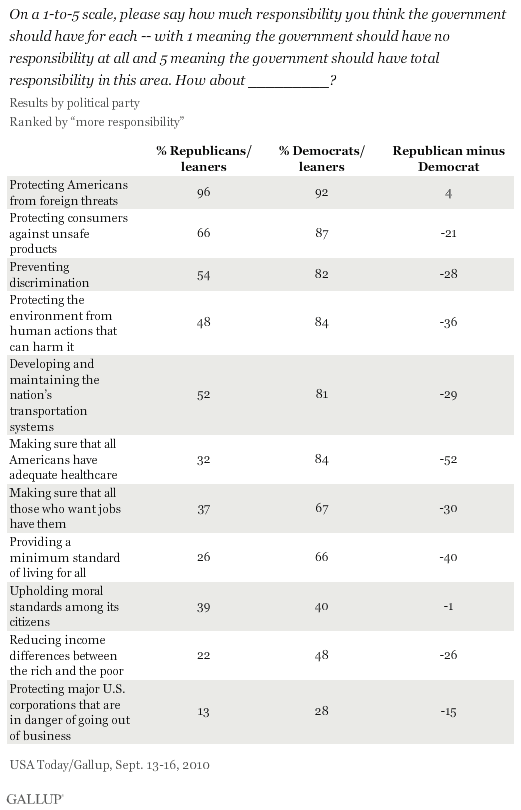PRINCETON, NJ -- Americans are more likely to choose middle-ground responses rather than extremes when asked about the degree of responsibility the federal government should take for a number of social and economic functions it could in theory perform. For only two functions -- protecting Americans from foreign threats and protecting consumers from unsafe products -- does a majority say the government should be totally responsible.

These results are based on Gallup's annual Governance survey, cosponsored this year by USA Today and conducted Sept. 13-16. Americans were asked to rate each of 11 government functions on a 5-point scale, anchored at one end by the view that the federal government should have no responsibility for a given function, and on the other end by the view that the government should have total responsibility for the function.
Americans tend to use the middle 2, 3, and 4 points on the 5-point scale in their answers, avoiding the two extreme end points. This suggests that Americans are not monolithically set in stone in their views of the role of their federal government, but instead recognize that the government has some responsibility, even if limited, in most areas of society.
Overall, a majority of Americans give a 4 or a 5 rating for 7 out of the 11 functions tested, meaning that their views for each of these range toward the "more responsibility" end of the scale rather than the "less responsibility" end. These seven functions include foreign threats, protection against unsafe products, preventing discrimination, protecting the environment, developing and maintaining the nation's transportation system, making sure Americans have healthcare, and making sure all who want jobs have them.

The only function on which a majority of Americans give a 1 or a 2 rating is "protecting major U.S. corporations that are in danger of going out of business."
Democrats More Likely to Say Government Should Be Responsible
Today's political environment is highly partisan, making it less than surprising to find sharp partisan differences in views on the responsibility that the federal government should have for the 11 functions tested in this research.

Democrats are more likely than Republicans to give a 4 or a 5 rating (that is, responses on the "more responsibility" end of the scale) to all of the functions except one -- protecting Americans from foreign threats. The gap between Democrats and Republicans on one additional function -- upholding moral standards -- is one percentage point.
The partisan gap is largest on the healthcare dimension, with 84% of Democrats placing themselves on the "more responsibility" end of the scale, compared with 32% of Republicans. Other functions with a 30 point or higher partisan gap include: providing a minimal standard of living for all, protecting the environment from human actions, and making sure that all who want jobs have them.
These data underscore the general conclusion that Democrats are significantly more inclined to see government as being responsible for addressing or ameliorating society's problems than are Republicans. Views of the government's role in protecting the country from foreign threats and upholding moral standards provide the lone exceptions.
Implications
Americans today see the federal government neither as an entity that should be totally responsible for protecting and providing for its citizens, nor as an entity that should have no responsibly for these functions. Instead, the public tends to operate in a "middle zone," believing that while government should have at least some responsibility for many functions, it is not to be totally responsible.
Much of the current debate on the role of government has been focused on the actions of conservatives and Tea Partiers who argue for a much more limited government, and also on the actions of President Obama and Democratic leaders who argue that government has a major responsibility for helping solve society's problems. These data suggest that the American public, taken as a whole, operates somewhere in the middle between these two extreme perspectives.
Results for this USA Today/Gallup poll are based on telephone interviews conducted Sept. 13-16, 2010, with a random sample of 1,019 adults, aged 18 and older, living in the continental U.S., selected using random-digit-dial sampling.
For results based on the total sample of national adults, one can say with 95% confidence that the maximum margin of sampling error is ±4 percentage points.
Interviews are conducted with respondents on landline telephones (for respondents with a landline telephone) and cellular phones (for respondents who are cell phone-only). Each sample includes a minimum quota of 150 cell phone-only respondents and 850 landline respondents, with additional minimum quotas among landline respondents for gender within region. Landline respondents are chosen at random within each household on the basis of which member had the most recent birthday.
Samples are weighted by gender, age, race, education, region, and phone lines. Demographic weighting targets are based on the March 2009 Current Population Survey figures for the aged 18 and older non-institutionalized population living in continental U.S. telephone households. All reported margins of sampling error include the computed design effects for weighting and sample design.
In addition to sampling error, question wording and practical difficulties in conducting surveys can introduce error or bias into the findings of public opinion polls.
View methodology, full question results, and trend data.
For more details on Gallup's polling methodology, visit https://www.gallup.com/.
